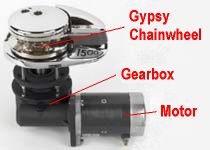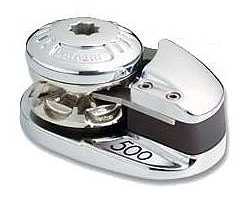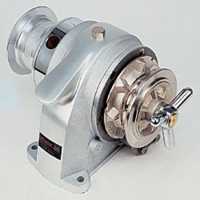Anchor Windlass

An anchor windlass is a mechanical aid to handle the anchor rod.
It is mounted on deck and it basically consists of a chain wheel or gypsy connected
to a gearbox and can be operated manually or electrically.
A manual windlass is cheap, reliable and does not require additional electrical
installation of power cables.
However, heaving anchor and chain on large vessels from significant anchor depths
may be tiring and slow.
Electric anchor windlass use a powerful electric motor to operate the windlass.
Safety, practicability and fast operation are the advantages.
The power used by the electric anchor windlass is not a real problem;
modern yachts have sufficient battery capacity to run the electric
anchor windlass for the few minutes it is operated.
Two reasons for installing an anchor windlass are safety and utility.
The anchor windlass on a boat allows to handle different anchoring
situations, even the most critical, always safely.
The size and type of windlass that is required will depend on a number
of factors including:
- The length and displacement of the vessel
- The size of chain and/or rope used in the anchor rod
- The weight of the anchor
It is also very important to consider the conditions in which the anchor
gear is used and the functions that it is required to perform.
Some Remarks:
The windlass does not stow the anchor rode in the locker. Gravity stows the rode in the locker.
There must be a free and clear area under the hawse pipe for the incoming rode to lie.
If not, the rode will jam. A windlass is a retrieval device designed to lift the anchor and rode.
It is not a high-load-bearing device, so when at anchor the rode should be secured to a chain stopper, a cleat or other
mooring point on the bow. Neither should a windlass be used to pull the boat up to the anchor nor to break the
anchor free from the bottom.
Types of Windlass
|
There are two different types of anchor windlass, vertical anchor windlass
and horizontal anchor windlass. This is based on the orientation of the drive
shaft axis - vertical or horizontal in direction.
|
Vertical Windlass: The running gear, gypsy and capstan are positioned
above the deck with the motor and gear drive below.
With most of the mechanical components under deck, the maintenance
operations are less simple than the horizontal anchor windlasses.
The main advantage of this type of anchor windlass is that the profile deck
is very compact as the electric motor and the gearbox are protected under the deck.
They are lighter than the horizontal anchor windlasses and their price is
more competitive.
Vertical windlasses operate at optimum with greater anchor rode fall than the horizontal
windlass and a minimum fall of 40cm from top of stacked anchor rode is recommended.
This is particularly important if using nylon line which does not fold and stack as well
as chain does.
A vertical windlass provides a 180-degree wrap of the anchor rode around the gypsy for
maximum feed into the locker and prevention of chain slippage and jumping.
|

|
Horizontal Windlass: This type features fully enclosed, easy above deck installation, and is
usually preferred where locker space is limited and additional fall is required.
The motor and gear drive are fully enclosed in the housing with nothing protruding below deck.
The horizontal windlass operates with optimum anchor rode fall of at least 30cm from the
top of the stacked anchor rode, and due to the horizontal orientation of the gypsy higher
above the deck, there is additional fall provided. Drawback is that the gypsy grips
the chain or rope only over a 90-degrees angle. |

|
Required Power
In general, windlasses and their power system should be capable of lifting the anchor and
all its rode (chain and rope) if deployed so that it hangs suspended in deep water.
This task should be within the windlass' rated working pull, not its maximum pull.
A rule of the thumb for the required working power can be found in windlass catalogues:
working load [W] = 4 * total weight of ground tackle [kg].
The choice of model and power should be done considering length and
displacement of the boat.
On the following pages there are helpful selection charts to choose
the proper model for your boat.
This cover a lot of important of important parameters, which will
address some of your questions to the different choices.
That is because, it is not possible generalise with formulas,
calculations or different charts, as there are plenty of situations
due to the type of boat, the skill of the person who is making the
anchoring operation, the wind force and sea condition.
These selection charts are the result of thirty years of experience and it must
be considered as an important reference.
Most of the comparisons between windlasses is done following the data declared
from the manufacturer against which windlass is recommended for a specific
length of boats.
That could be a mistake!
From our point of view, to get a correct evaluation, the windlasses should be
compared for sizes, weight, mechanical strength, power and other visible features,
so please do not compare windlasses having different features just because both
the manufacturers recommend them for the specific length of boat.
Most of our anchor windlasses are available in two different electric motors,
a powerful electric motor which is faster and has more pulling power, and a
smaller one with a lower current draw so it is possible to use smaller cross
section electric cables.
To make windlass, it is extremely important to select light weight,
high mechanical strength and corrosion proof materials to increase
durability by chemical or galvanic treatments thus improving their
anti-corrosion properties.
It is essential to manufacture and design all the components of
the windlass, avoiding the use of motors, gearbox or other components
not coming from marine fields, certainly more economic, but far less
appropriate in the harsh environment that yachts and boat find
themselves sailing in.
For this reason, all the components of a windlass should be designed
and manufactured for a sea environment, despite the increase on
costs.
Hot forged components, e.g. wingnut, gypsy, gear wheel, clutches are
supplied on the most of our windlasses.
The hot forging process is more expensive than the traditional
casting process, but provides high mechanical strength components,
a more compact molecular structure and a better surface condition.
List of materials on some relevant windlass components
The main shaft is in stainless AISI 431 with a high mechanical strength.
The body of the windlass, the drum and various components are made
in a special aluminium alloy, polished and anodised or powered by
a white polyester paint.
The worm-wheel is in alloy bronze - worm is in 38NCD4 steel.
Screws and outer components are in stainless AISI 304 or AISI 316.
Gearbox
Our gearbox at high mechanical efficiency are designed and made
for marine use.
The ratio from 1/50 up to 1/75 is the right compromise between
performance and speed.
The long life oil bath lubrification protects the internal components
of the gearbox from wear and tear and reduces the noise.
The gear case is black anodised for a long-life protection.
Electric Motors
Our electric motors are designed and made for marine use.
They have particular features:
Manufactured IP 56 degree of protection (DIN 40 050) - protection
against deckwater.
Shaft, screws, nuts and cover made in stainless steel
Electric motor case protected by a black paint
Most of electric motors are series-wound.
They have the advantage in comparison with the less expensive
permanent magnet motors to produce an initial starting torque
which can be useful in critical situations.
Haulage Speed
For each model it is indicated the haulage speed at a specific
load, in kilogrammes.
This specific load was chosen according to the features of the
windlass and their average uses.
For instance a 400 Watt model we considered a specific load
of 25 Kg, for a 1000 Watt model the specific load is 50 Kg.
Naturally powerful models ask for greater specific load.
It is important to consider the haulage speed of the windlass
depending on the lifting load, increasing when the load is lower,
so the electric motor of the windlass change speed in order to
the request torque to lift chain and anchor.
Maximum Pull
It is the maximum pull that a windlass can provide for a few seconds.
This is measured by a dynamometer put between the gipsy and the bow roller.
The greater this value the more the windlass is able to get the anchor afloat.
This value does not coincide with the maximum lifting ability
of the windlass, which is influenced by some factors, e.g. using a
medium quality bow roller and with a working angle of 90 degrees,
the real maximum lifting ability is approximately half of the maximum pull.
Specific Chain Weight
The weight of the anchor chain not only plays an important role for damping the movement of
the yacht at anchor. While lowering the anchor and the chain in great dephs (> 20 Meter)
the windlass will have to be laid out to lower and heave the weight of the anchor and
additional chain.
A 10-mm chain (stainless steel) has a specific weight of 2.25 Kg/M. So a 100 Meter chain will
weight 225 Kg.
Anchoring in 20 meters (which is too deep for e.g. a 60 M chain) will load the windlass with
about 70 Kg (45 Kg chain and 25 Kg anchor).
Notice, that under water bodies are lighter that in air. Steel has a specific weight of about
7750 kg/m3. A body of one cubic meter under water however has an uplift of 1000 kg. So for
steel bodies the weight will be reduced by about 13% (1000/7750) by submerging them in water.
So in the example above, 20 Meters of chain and a 25 Kg heavy anchor will have an weight of about
60 Kg under water.
Windlass
What are the Watts in the windlass specs??
e.g. what weight can a 1200W Windlass realy heave?
depends on the retrieving speed, gearbox etc ...
-
Inspection of some windlass specifications in marine catalogues shows the following:
a Windlass with a wattage of X Watt features a maximum load of X kg:
a 1000-W Windlass can deliver a maximum load of 1000 Kg!
This seems remarkable because according to basic-school physics, a mass of one Kg is pulled down by
gravitation with 9.81 Newton and provided the windlass can pull in the chain with about 0.5 m/s, a power
of 1000W would imply a load of 200 Kg: 1000W = 200 Kg * 9.81 m/s2* 0.5 m/s!!!
- retrieving speeds are in the order of 0.2 to 0.5 m/s (this means: half a knot to one knot reverse speed during the
anchorage manouvre).
- there exist windlass models with two different speeds: one pay-out speed in the order of 0.5 to 1.0 m/s; and a
retrieving speed of 0.2 to 0.5 m/s. This allows for faster anchorage speeds e.g. when exposed to
unfavourable side winds.
-
There exist a range of vertical and horizontally configured windlasses that can take rope,
chain or a combination of both.
These are fitted either with separate rope and chain gypsies or may have a special gypsy design that
can handle both rope and chain on the same gypsy provided the rope is spliced to the chain and the
splice fits in the gypsy.
Using a combination of rope and chain together reduces the overall weight of the anchoring system,
often critical for high performance vessels.
|
 An anchor windlass is a mechanical aid to handle the anchor rod.
It is mounted on deck and it basically consists of a chain wheel or gypsy connected
to a gearbox and can be operated manually or electrically.
An anchor windlass is a mechanical aid to handle the anchor rod.
It is mounted on deck and it basically consists of a chain wheel or gypsy connected
to a gearbox and can be operated manually or electrically.
